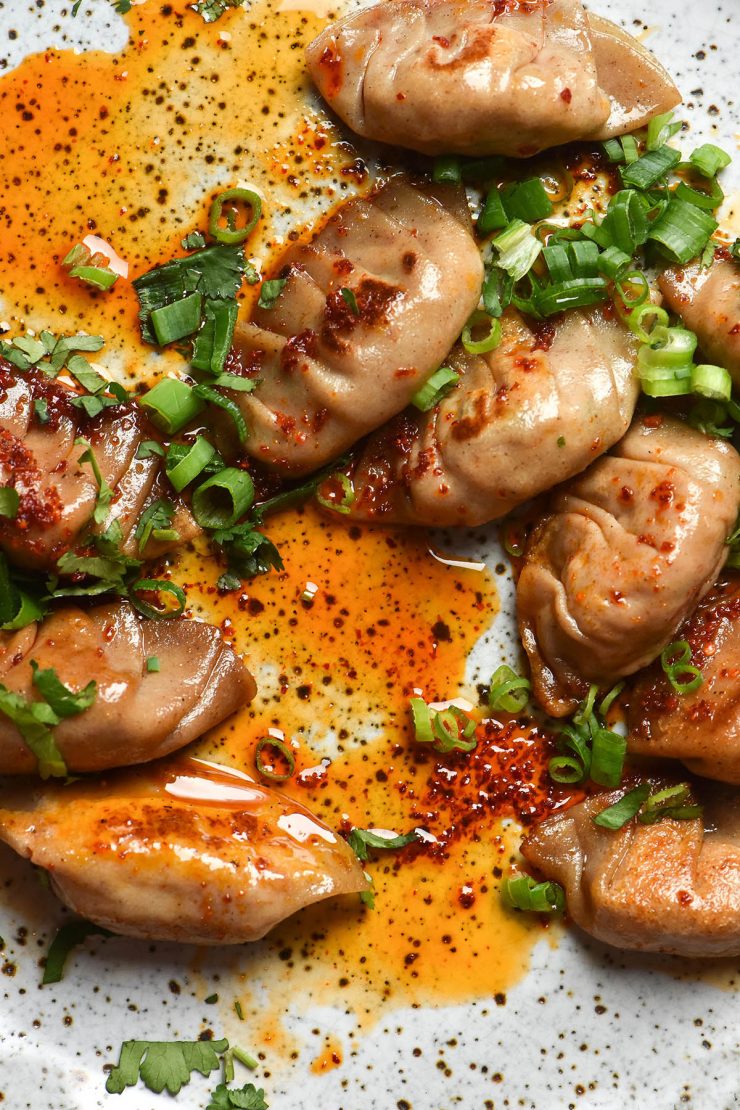
My gluten free dumpling wrapper recipe is one of my favourites that was originally in my cookbook, Intolerance Friendly Kitchen. It produces easy, flexible and foldable gluten free dumpling wrappers without the need for xanthan gum. However, I have never tested a recipe for those who can’t have rice flour. Today that changes with this recipe for gluten free dumpling wrappers without rice flour.
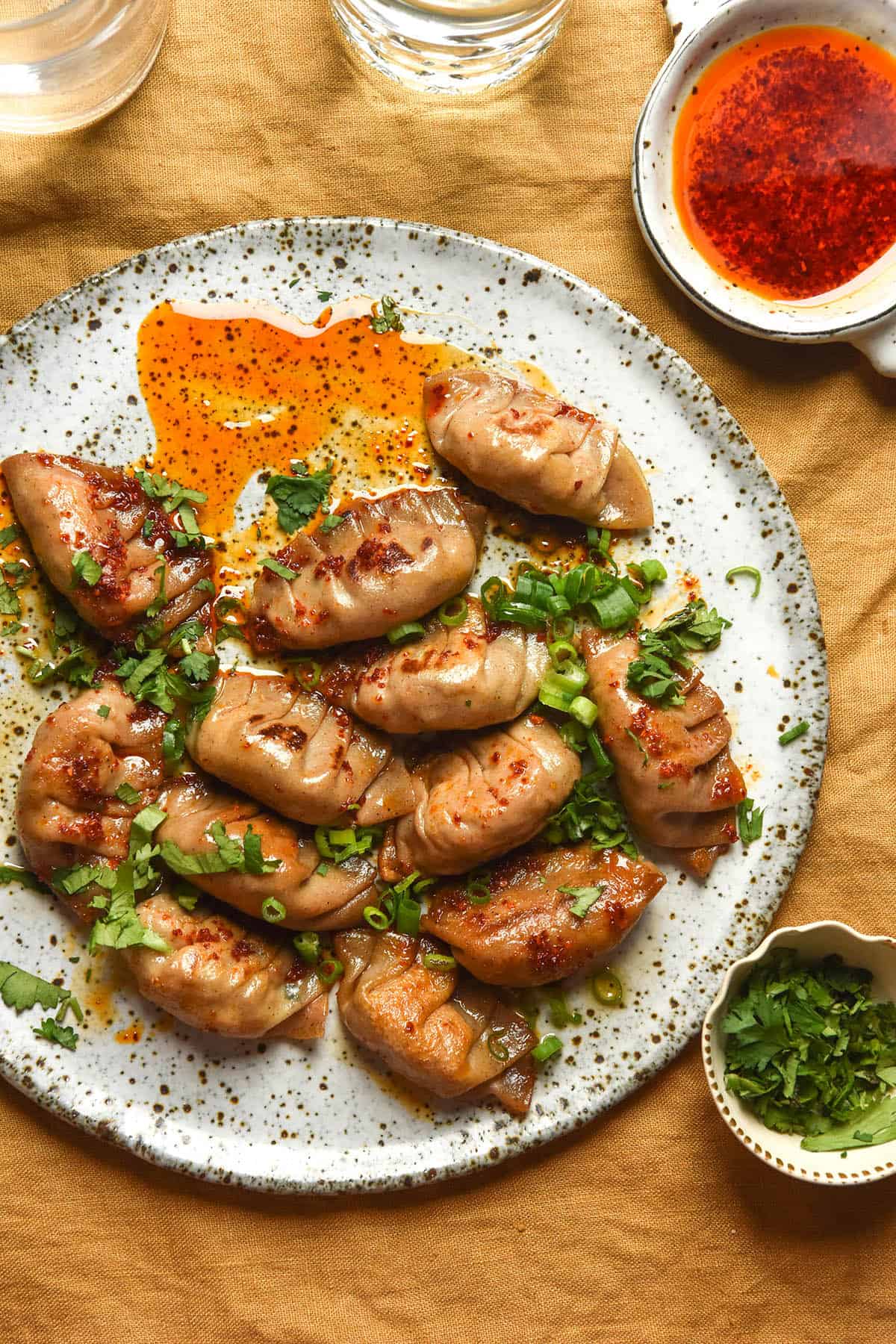
Gluten free dumpling wrappers without rice flour
These gluten free dumpling wrappers are xanthan gum free, dairy free, egg free and rice flour free. They use a simple mix of one gluten free starch and two gluten free wholegrain flours. They are made flexible and foldable with the use of psyllium husk powder and a scald.
The wrappers are open to experimentation and are generally easy to adapt to your dietary requirements. I find that they require more elbow grease than the rice flour version, which tends to create quite a soft dough. That said, they are still easy to roll and fold without incident.
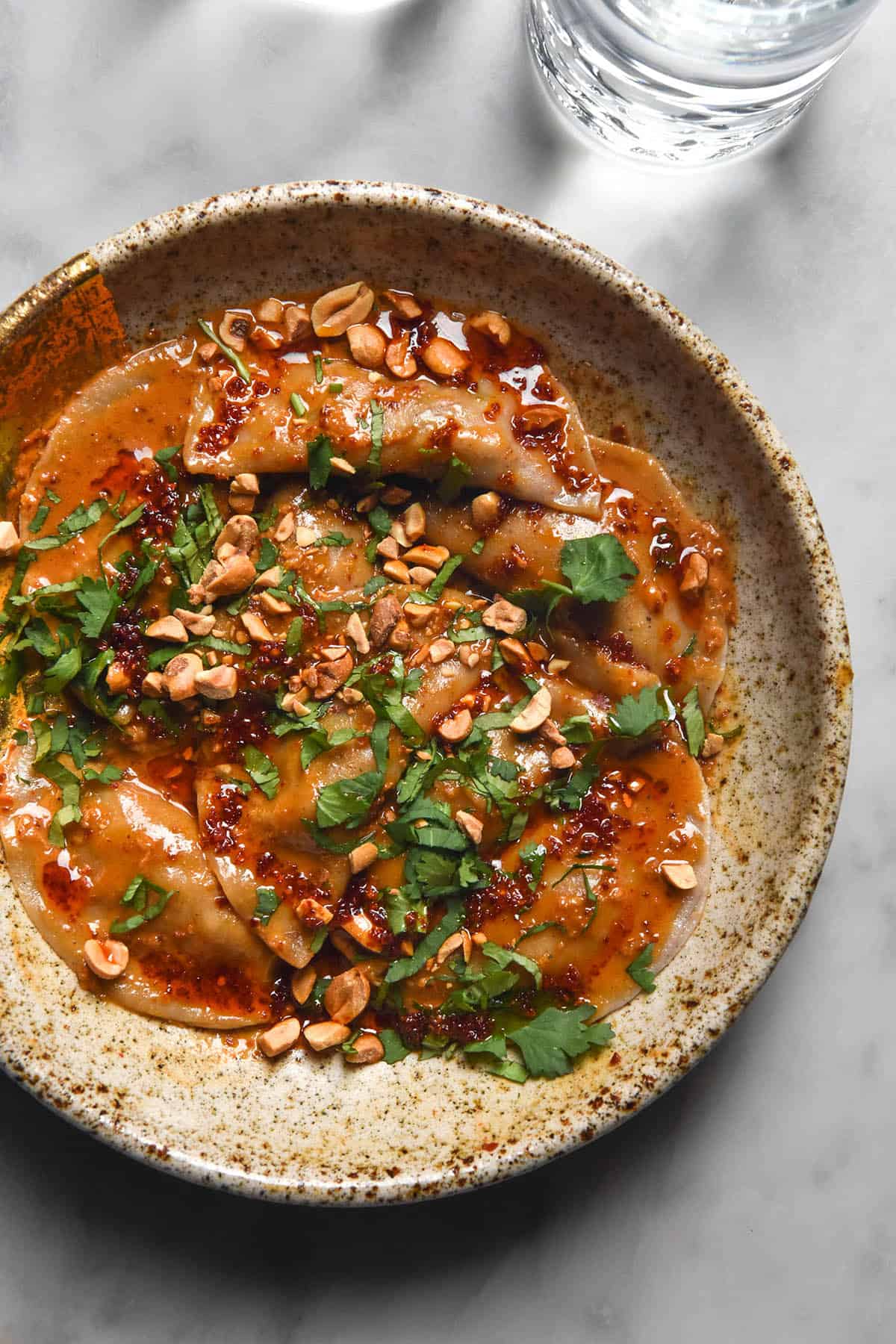
What is a scald?
A scald is the simple process of pouring boiling water over flour. The boiling water gelatinises the flour which makes it more flexible and elastic. This is super important in a gluten free dough, which generally has little to no elasticity.
Scalding dough also allows you to add more liquid than you could ordinarily without creating an overly wet dough. Moisture is key to edible gluten free goods, which tend to be very dry, so the scald really works like magic in this instance.
My experience with scalding is that wholegrain gluten free flours respond far better than starches. A dough with both starch and wholegrain scalds nicely, but an all starch dough tends to clump or ball up.
Combining a scald with psyllium husk powder allows the dough to absorb sufficient liquid and creates plenty of elasticity. This make rolling these gluten free dumpling wrappers out as painless as possible.

Which gluten free flours does this recipe use?
As the title suggests, this is a rice flour free recipe. I chose to use tapioca flour, buckwheat flour and quinoa flour as they are the easiest to purchase from supermarkets here in Australia. I wanted the recipe to be as accessible as possible.
With that said, this dough is very amenable to adaptations. I intend to gradually test more options when my freezer isn’t so full of leftover dumplings. Have a read of the section below on adjusting the dough to your requirements.

Can I use different flours in this dough?
Yes, you can, but you will be experimenting. The dough is easy to adapt, but how much liquid you need to add will depend on the flours you’ve used, hence the experimentation.
Different gluten free flours absorb liquid differently, so you will need to have your wits about you as you change the dough. I have found that teff and sorghum flours absorb a considerable amount less liquid than rice flour, for example. Similarly, glutinous rice flour absorbs more liquid than tapioca flour.
With this in mind, here are some tips for making the dough your own:
- This dough requires more elbow grease than the white rice flour version. As such, I recommend keeping the starch component of the dough at 120g. I have successfully tested a version with only 60g of starch, but it was very sturdy and required some effort to roll out. It is an option if you are looking for a low starch option, though. For a starch free version, see my 100% buckwheat flour dumplings in my buckwheat e-book.
- If you are using sorghum, millet or quinoa, I recommend using 2 wholegrain flours for the wholegrain component. These flours can be bitter when used in large quantities, so it’s best to mix them with another wholegrain.
- I have recently noticed that store and bulk food store quinoa flour tends to be bitter and rancid. I recommend grinding your own from whole quinoa in a NutriBullet. It is quick and easy to do.
- Add water conservatively at the beginning if you intend to mix up your own flours. Because different flours absorb liquid differently (even different bags of the same flour absorb liquid differently) your dough will have unique hydration requirements. You can always add more later, but it’s harder to correct an overly wet dough.

Tips for your gluten free dumpling wrappers without rice flour
My main tip is to expect that this dough is a little harder to roll out than the rice flour version. There is something about white rice flour that seems to respond really well to a scald. It creates a very juicy and elastic dough that is soft and rolls out easily.
Dough without rice flour, I find, tends to be a little more like pasta dough in consistency. It’s more sturdy and requires a bit of pressure to roll out. While you can pleat these dumplings, they’re a little more prone to tearing than the white flour version.
Of course, there’s also the visual aspect. White rice flour is one of the lightest coloured gluten free flours. Using other gluten free grains, like buckwheat or quinoa, tends to produce a more ‘wholemeal’ looking dumpling.
If you get to the end of folding your dumplings and find a (small) tear in the wrapper, fear not. First, you can dab the tear with water and rub it until the tear (hopefully) disappears. If that doesn’t work, set the dumpling aside to be pan fried. Pan frying torn dumplings is easy and ensures you don’t end up with a waterlogged dumpling. Instructions on pan frying the dumplings can be found below.
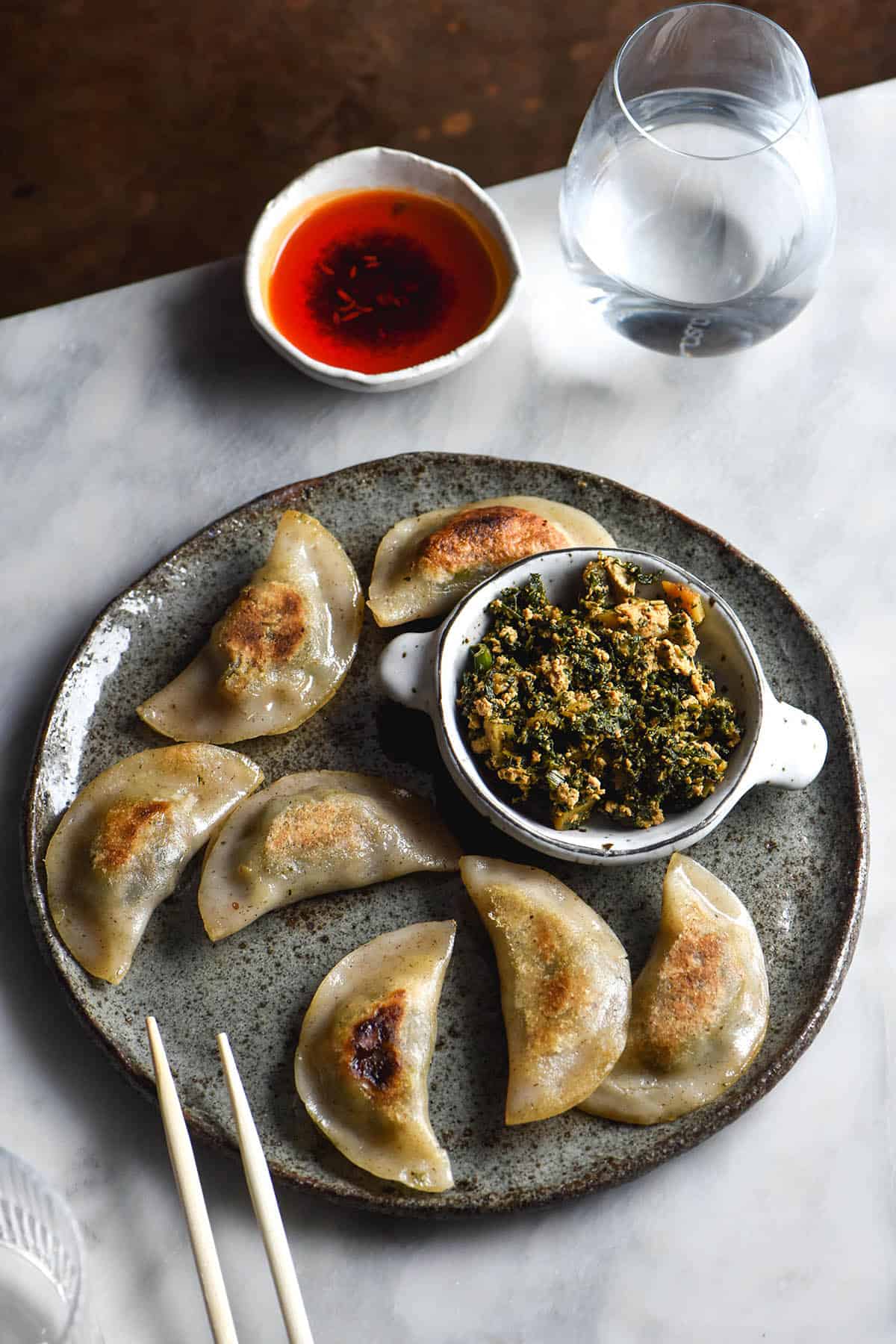
How to pan fry your gluten free dumplings
As we have discussed, frying your dumplings is a great way to cook them if they have a few tears. Dumplings with holes generally either get soggy inside while boiling or they fall apart completely as the boiling water knocks them around.
To fry your dumplings, heat a pan with non stick qualities extremely well. Anything less than completely screaming hot is likely to result in a bunch of dumplings stuck to the pan. For me, my pan took about 3-5 minutes of preheating, without oil, on a medium heat on my largest burner.
Once the pan is thoroughly heated, add some oil and allow it to heat until shimmering. Add the dumplings in batches to give them space. 10 or so seconds after I add the dumplings, I like to move each one to ensure it isn’t stuck. Adjust the heat as necessary.
Continue to cook the dumplings and flip them until they are golden brown on either side.
Grab a lid that sits over your pan and about 60-80ml (1/4-1/3 Australian cup) of water. Pour the water over the dumplings (careful, it will spit a bit) and pop the lid on. Continue to cook until the water has evaporated, then remove the lid.
Keep in mind that this will take longer and might need more water if you are using frozen dumplings or if you didn’t roll the wrappers thinly enough.
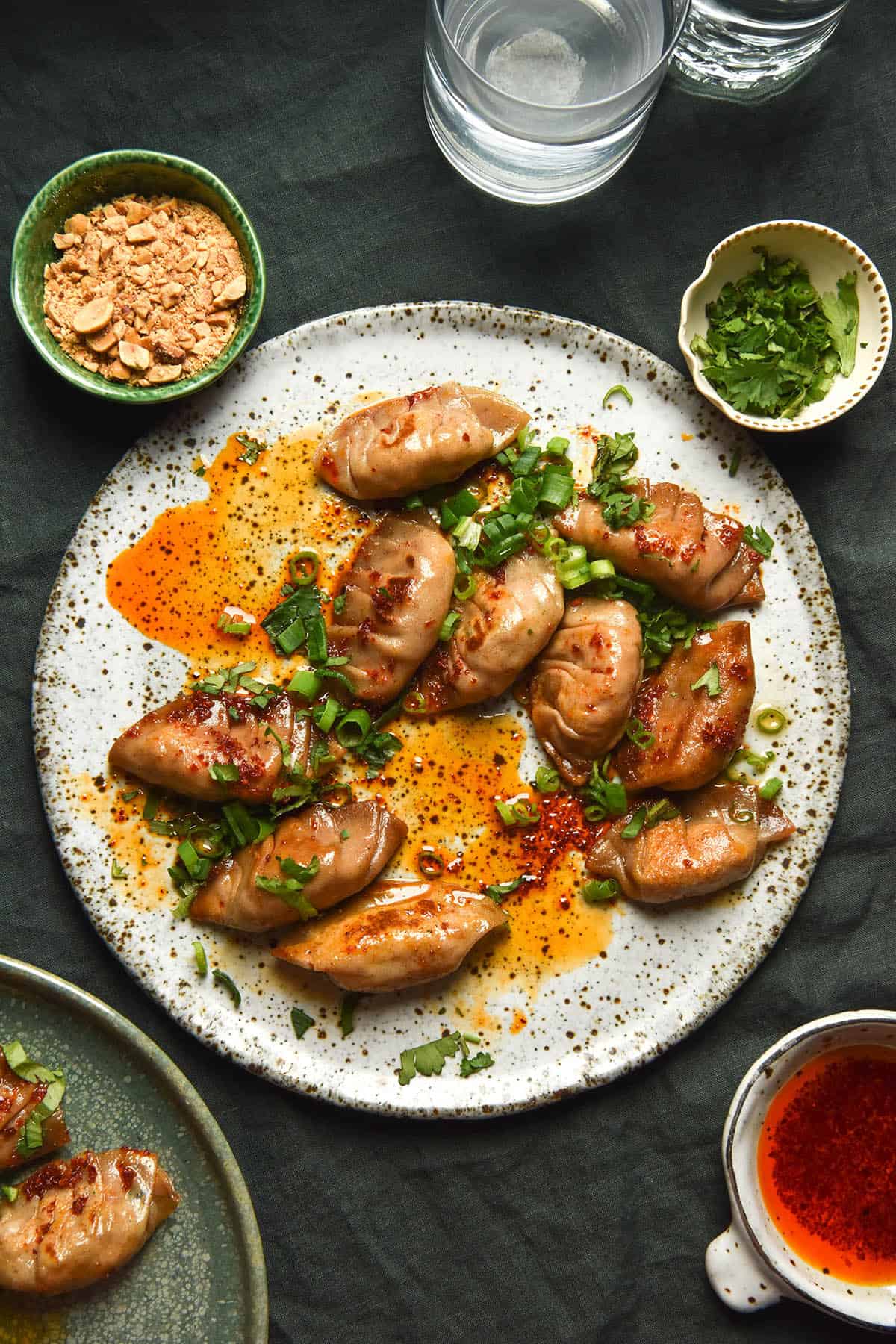
Recipes to go with your gluten free dumpling wrappers without rice flour
- Low FODMAP tofu and bok choi dumpling filling
- Low FODMAP dumpling sauce
- Gluten free skirt dumplings from my cookbook, Intolerance Friendly Kitchen
- Low FODMAP chilli crisp

Gluten free dumpling wrappers without rice flour
Equipment
- 1 X 9.5 cm /3.7 inch cookie cutter (to cut the dumplings)
Ingredients
- 120 g light buckwheat flour
- 120 g quinoa flour
- 120 tapioca flour
- 20-25 g psyllium husk powder
- Pinch of salt
- 40 ml 2 tablespoons oil vegetable or peanut work well, but really any oil will work
- 250 –375 ml 1–1½ cups boiling water, just enough to form a dough
- Extra tapioca flour for rolling
Instructions
- Combine flours, psyllium and salt in a large bowl. Whisk in the oil and enough boiling water to form a damp but crumbly dough. If in doubt, err on the side of caution – you can always add more water later. This applies particularly if you are experimenting with different gluten free flours (see notes in the body of the post).
- Turn the mixture out onto a clean, dry bench top. Allow it to cool for a minute or two before beginning to knead with your hands. It will be hot, so be really careful. Continue kneading until a smooth and pliable dough forms. If it doesn’t, add half a tablespoon of hot water at a time until you reach a good consistency.
- Tear off a golf-ball-sized piece of dough and cover the remainder. Roll dough out on a well-floured surface (I use tapioca flour) until it is around 2mm thick, keeping in mind that it swells a little during cooking. I recommend putting in the effort to roll them as thinly as possibly – it makes them easier to fold and nicer to eat.
- Use a medium-sized circular cookie cutter (or an upside-down glass) to cut out rounds of dough. Mine is 9.5 cm. I like to fill and shape the dumplings as I work, but you can roll them all out before filling if you prefer. Just make sure to flour in between the rolled-out wrappers well and keep them covered if you choose the latter option.
- Re-roll any excess dough as you work. You might need to moisten trimmings with wet fingers to return it to its pliable glory. Repeat with the remaining dough until it is all used.
- Fill your dumpling wrappers with a teaspoon or two of your filling of choice. Use water to thoroughly seal the dumpling edges together in any sort of pleating style you like. I like to really squish the edges together to ensure the dumplings won't split upon cooking. Repeat until you have filled all the dumplings. If you have any dumplings with small tears, see the notes in the body of the post about pan frying them.
- To cook, boil a medium pot of lightly salted water. Once it is boiling, reduce it to a simmer and add 5-6 dumplings to the water. Stir very gently to ensure they don't stick to each other, and reduce the heat if it returns to a rolling boil at any point. A strong boil is more likely to break up your dumplings, so make sure you keep it to a low boil or even a simmer.
- Cook each batch of dumplings for 3 or so minutes or until the wrapper starts to look a bit translucent. Be sure to flip them over so that both sides are cooked through. Remove from the water and place into a strainer to cool. Very lightly oil each batch of dumplings with toasted sesame oil to ensure they don’t fuse together. Repeat until you have cooked all the dumplings you need.
Notes
- Read the notes in the body of the post to ensure success. I don’t write them for fun 🙂
- See the notes in the body of the post in terms of flour substitution options.
- I used the low FODMAP tofu dumpling filling in my cookbook, Intolerance Friendly Kitchen. This is a similar recipe to my tofu bok choi filling recipe and makes the same amount.
- I recommend filling the dumplings before freezing. I suspect that frozen unassembled wrappers would be a nightmare to defrost. I also find that the wrappers are most flexible when the dough is fresh.

No Comments